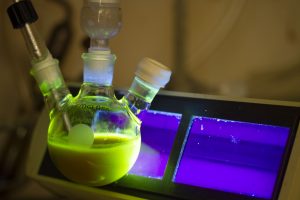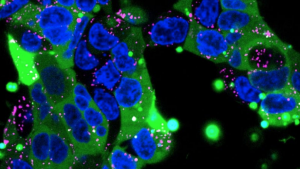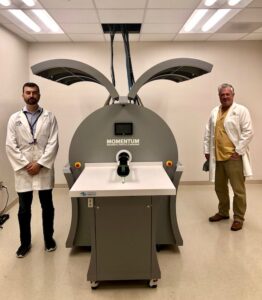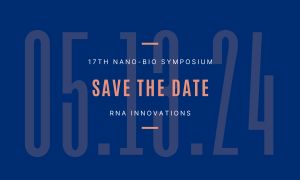Visualizing Immunity – Insights from Multiplex Dynamic and Static Tissue-scale Imaging
Presented by: Dr. Ronald Germain
Chief, Laboratory of Immune System Biology
Chief, Lymphocyte Biology Section
Director, Center for Advanced Tissue Imaging (CAT-I)
Abstract:
Immune responses involve cell interactions within lymphoid and peripheral tissues including tumors. To gain insight into the relationships between immune function and the local tissue environment, we have developed new multiplex 2D (IBEX) and 3D (Ce3D / Ce3D-IBEX) optical imaging pipelines and associated computational methods (RAPID and SPACE) for quantitative, spatially-resolved image analysis.
IBEX is an open-source method for iterative imaging used to probe fixed frozen or FFPE mouse and human tissues to as many as 80 parameters at ~ 300 nm lateral resolution. More than 1000 antibody conjugates have been validated for IBEX and a website provides details on these reagents. Ce3D (clearing enhanced 3D) is a fast-clearing technique giving excellent signal intensity from directly conjugated antibodies, permitting a high level of multiplexing and IBEX cycling.
Using these methods we have discovered novel commensal-dependent immune clusters at the junction of vagal sensory neurons in normal lungs. In cancers, these tools have revealed how immunotherapy converts suppressive Tregs into type 1 interferon-gamma producing effectors and the unanticipated negative effects of checkpoint therapy on stem-like memory T cells. A method for identifying T cells actively signaling through the antigen receptor has enabled us to identify antigen reactive cells in fixed tissue and to identify the cognate antigen presenting cell. Ce3D has been used to quantify antigen-specific cells in entire lymph nodes, revealing that suppression of autoreactive T cells by Tregs operates by promoting abortive proliferation.
These findings illustrate the power of in situ imaging for probing the molecular, cellular, and spatial aspects of immune responses in situ.
This work was supported by the Intramural Research Program of the NIAID, NIH.
Bio:
Ronald N. Germain received his M.D. and Ph.D. from Harvard University in 1976. Since then he has investigated basic immunobiology, first on the faculty at Harvard, then at NIAID, NIH. He has contributed to understanding MHC class II molecules, antigen processing, and T cell recognition, more recently pioneering analysis of the immune system using dynamic and static in situ microscopy. He has published more than 400 scholarly research papers and reviews and trained more than 80 fellows. Among other honors, he has been elected to the National Academy of Medicine, the National Academy of Sciences, EMBO, AAAS, the American Academy of Arts and Sciences, named a Distinguished Fellow by the American Association of Immunologists., and designated a Distinguished Investigator by NIH.
In-person Class Held in Hodson 210
Zoom Link: Passcode 530803: Meeting ID: 955 8366 7779
Open to any student-led team that has designed a health-related solution. All countries. All academic fields.
A competition to celebrate good design in healthcare. Winners show a solid understanding of the need, the people impacted, focused problem-solving, and a great real-world solution.
Timeline:
February 12 – Submission of two-page proposals
March 18 – Finalists informed
April 13 – Final round (virtual event)
Eligibility for Application:
Project must be focused on a healthcare application in either of the four tracksDesigns of Solutions for Advanced Health Systems
Global Health/ Humanitarian Design
Healthcare Apps/ Digital Health
Post-Surgical Infection Management
Project must have been started after January 1, 2022
Project must be driven by full-time studentsPostdoc research projects are ineligible.
Projects that have utilized significant funding (>$100K) are ineligible.
Projects that are not run by full-time students are ineligible. For example, projects run by startup companies or faculty are ineligible.
Eligible full-time students include those working towards undergraduate, masters, doctoral, and professional degrees (MBA, MD, etc.).Project teams should comprise of more than one full-time student.
Applicants can submit multiple unique projects

Join the community at the Whiting School of Engineering during the week of February 19 through 23 for Engineers Week, a national, annual celebration of the vital contributions that engineers make to the world.
Agenda
Aerospace and Aviation – Monday, February 19
WSE’s 14th Annual Speed Networking Night- Tuesday, February 20
Society of Women Engineer’s Tower of Power – Wednesday, February 21
Night at the Museum for WSE Graduate Students – Thursday, February 22
Career Fair – Friday, February 23

Scientists and engineers across many fields and disciplines are united by their work at the nanoscale. Their diverse efforts have helped produce everything from faster microchips to powerful mRNA vaccines. The transformative impact of this work has been spurred by the coordination and focus on U.S. nanotechnology established by the 21st Century Nanotechnology Research and Development Act in 2003. Celebrating such a broad impact and envisioning the future can be quite challenging, but this event will bring together voices from across the emerging technology landscape. There will be experts who can speak on the importance of nanotechnology in quantum engineering, optics, EHS, plastics, DEIA, microelectronics, medicine, education, manufacturing, and more. We can’t predict what will emerge from this lively discussion between researchers, policymakers, members of industry, educators, and the public, but the conversation can only benefit from including more diverse perspectives – especially yours.

The Johns Hopkins School of Medicine Department of Radiology and the KKI F.M. Kirby Research Center invite you to their first locoregional MPI Workshop, organized by Adnan Bibic and Jeff W.M. Bulte, where they will discuss the opportunities that Magnetic Particle Imaging (MPI) can provide for molecular, cellular, and functional imaging of biological processes in living organisms.
This event serves two purposes:
1. Introduction to MPI: They will provide an overview of the emerging MPI technology and what it can do that other non-invasive imaging modalities cannot.
2. Sharing Insights: Existing users will present their cutting-edge research findings, with the goal to foster new collaborations and generating new ideas. Interested people from other institutions in the Mid-Atlantic region have been invited to participate.
What is MPI?
MPI is an emerging non-invasive imaging technique that directly detects magnetic nanoparticles acting as a “cold” tracer imaging agent. Similar to “hot” radiotracers used in nuclear medicine, it is quantitative providing specific information without background signal. It is ultra-sensitive, currently used here in rodents, and in further clinical development elsewhere.
What to Expect
1. Research Showcases: Hear about the latest advancements in MPI research.
2. Networking Opportunities: Connect with the regional MPI community.
3. Q&A Session: Engage with experts and share your thoughts.
4. Hands-On Demos: Experience MPI firsthand through demonstrations.
Registration
Join in person or stream online. Register by March 8, 2024 to secure your in-person spot. They have a maximum of 40 participants. If you can’t make it in person, all registered participants will be able to stream in except for the hands-on demo. Contact adnan.bibic@jhmi.edu to register.
Location
Kennedy Krieger Inc.
707 N. Broadway, Room 510
Baltimore, MD 21218
The Johns Hopkins University Life Design Lab, the Carey Business School and FastForward U are partnering to bring Baltimore-region startups together with Johns Hopkins undergraduate and graduate students for this event!
Who: Undergraduate and graduate students from all years are encouraged to attend.
What: An opportunity to connect with startups and start building connections. All employers at this event will have some kind of opportunity for paid student engagement.
What to Do in Advance: Upload a resume to Handshake, research participating employers you would like to connect with, and practice your elevator pitch
When: April 3 from 4:30-6:30pm EST.
Where: Hosted at Fast Forward U: 320 W 29th Street, 2nd floor, Baltimore, MD 21211
Please note: Professional dress is encouraged for all attendees.

Jordan J. Green is a professor of biomedical engineering, ophthalmology, oncology, neurosurgery, materials science and engineering, and chemical and biomolecular engineering. He currently serves as the vice chair for research and translation in the Department of Biomedical Engineering and previously served as the director of the undergraduate biomedical engineering program. He is the director of the Biomaterials and Drug Delivery Lab, the founding associate director of the Translational Tissue Engineering Center, and the founding associate director of the NCBIB Johns Hopkins Translational Immunoengineering Center. He is also an associate researcher in the Institute for NanoBioTechnology.
His research focuses on the design of biotechnologies for cellular engineering. Green and his lab design and synthesize new biomaterials and nanoparticle systems that can deliver biomolecules such as nucleic acids, peptides, proteins, sugars, and small molecules specifically to various cell types, including cancer cells, immune cells, and stem cells. His lab works to create innovative technologies and therapeutics that can directly benefit human health.
RSVP required for in person attendance. The event will be available via livestream for those unable to attend in person.
Design Day is the Whiting School’s premier event that showcases Hopkins engineering students’ work. Students implement their classroom knowledge, creativity, and problem-solving skills to develop inventions and processes that solve real-world problems and create a better future.
This event is open to all! We welcome faculty, staff, other students, and the public. Enjoy more than 200 student presentations, posters, and demos representing every academic department at the Whiting School, and speak with students about their work. For more information, visit the Design Day website, where you also can see examples of last year’s projects.
#JHUDesignDay24

All are welcome to attend our 17th Nano-Bio Symposium on RNA Innovations. All are welcome to attend our 17th Nano-Bio Symposium on RNA Innovations. Innovations in RNA biology and therapeutics show immense potential in transforming the landscape of medical research and biotechnology development. RNA, particularly messenger RNA (mRNA), has emerged as a groundbreaking tool and is revolutionizing the way researchers and clinicians approach medicine. This year’s symposium will explore the unprecedented possibilities of RNA innovations and its novel therapeutic avenues. We welcome experts, researchers, and enthusiasts to join us as we converge to share knowledge, exchange ideas, and delve into the latest advancements so that our collective efforts advance the full potential of RNA-based technologies and shape the future of healthcare and biomedicine.
This is event will feature guest speakers and a poster competition with a reception. Registration is required.

The Johns Hopkins Institute for NanoBioTechnology is accepting donations for BARCS, a non-profit animal shelter and pet adoption center in Baltimore.
BARCS is an open admission shelter, granting refuge to every abandoned, neglected, abused, lost, or surrendered animal that comes through their doors. No matter the circumstance, they do not turn away an animal in need of shelter, food, medical care, and a loving touch. Yearly, this equates to 11,000-12,000 dogs, cats, kittens, puppies, and even wildlife and exotic animals that need care and placement.
Please only purchase items from BARCS wish list. Below is a list of some of those items.
Drop off donations at the institute’s business office, Shaffer Hall 103 or contact to Gina Wadas at ginawadas@jhu.edu to arrange pick up.
Toys & Enrichment
Kongs
Nylabones
Scratch boxes for cats
Feather wands
Chuck-it balls
Veterinary Care
Latex and non-latex gloves
Triple antibiotic ointment
Digital thermometers
Kennel care
Stainless steel no-flip bowls
Baby wipes
Cat brushes
Kitten nursing bottles
Food & Treats
Dog/puppy food: dry and wet (unopened)
Cat/kitten food: dry and wet (unopened)
Bully sticks
Smooth peanut butter
Full Moon brand dog treats (Training Size)
Cleaning Supplies
Paper towels
Dawn dish detergent
Lint rollers
Plastic watering cans


